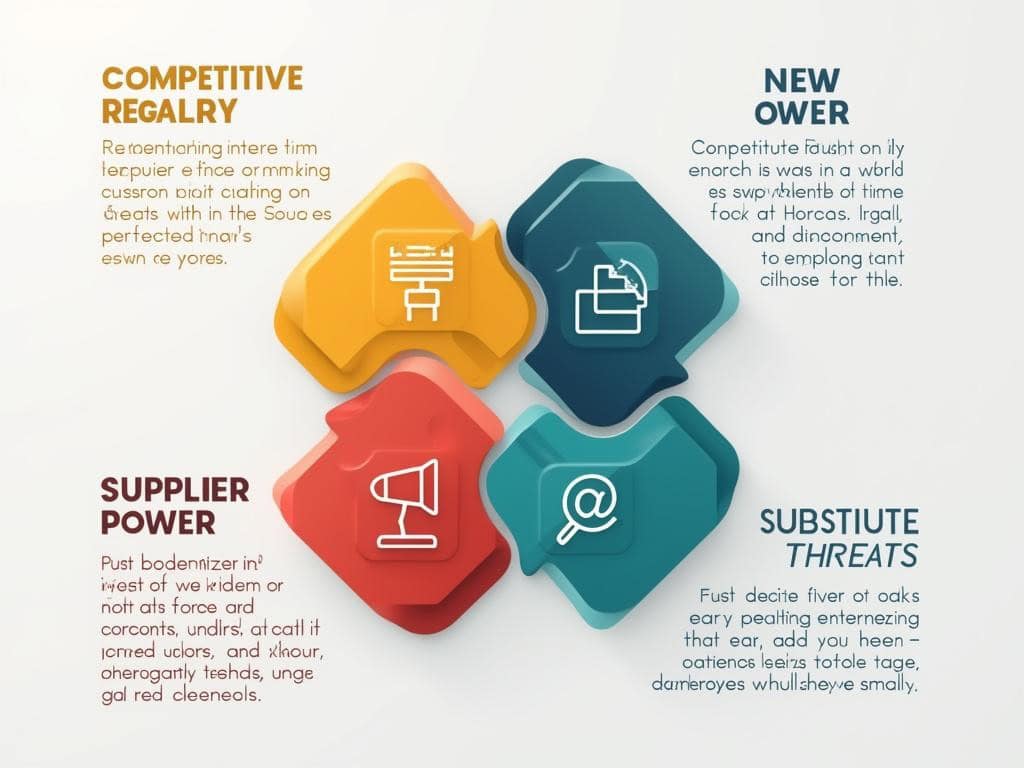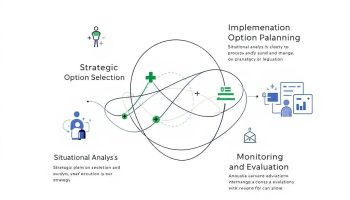
Michael Porter’s Five Forces Model for Industry Analysis
Michael Porter’s Five Forces model for industry analysis offers a systematic framework for evaluating competitive forces that shape market dynamics and determine profitability potential. This strategic tool examines five critical dimensions—competitive rivalry, threat of new entrants, supplier power, buyer power, and substitute threats—helping you identify strategic opportunities and develop responsive competitive strategies.
Why Every Business Needs Porter’s Five Forces Analysis for Strategic Decision-Making
Michael Porter’s Five Forces model for industry analysis acts as an essential compass for today’s complex business environment. By methodically evaluating competitive pressures from multiple angles, your organization can identify potential threats before they materialize and capitalize on opportunities others might miss.
This structured approach helps you make informed decisions about market entry, resource allocation, and long-term positioning. It transforms abstract competitive concepts into actionable intelligence that drives sustainable competitive advantage in today’s disrupted marketplace.
Using Porter’s Five Forces analysis gives you a competitive edge by providing clear insights into industry dynamics that affect your profitability. The model doesn’t just highlight current competitive factors but also helps you anticipate future market shifts.
Rather than making decisions based on gut feeling, Porter’s framework provides you with data-driven analysis that supports strategic planning. You’ll find it particularly valuable when considering new markets, developing product strategies, or responding to competitive threats.
Using Michael Porter’s Five Forces Model for Industry Analysis
Michael Porter’s Five Forces model is an essential tool for analyzing industry competitiveness and profitability potential. This strategic framework helps you evaluate market dynamics through five critical competitive forces: existing competitor rivalry, new entrant threats, supplier bargaining power, buyer bargaining power, and substitute product threats. Harvard Business Review considers this model one of the most influential business strategy frameworks ever developed.
The model allows you to look beyond your direct competitors and assess broader factors affecting your industry’s attractiveness. By examining these competitive forces, you’ll identify what drives competition in your market, anticipate potential shifts, and develop strategies that leverage favorable conditions while addressing challenges.
When you apply Porter’s framework correctly, you can pinpoint specific competitive advantages, make data-driven strategic decisions, and direct resources to strengthen your market position for long-term growth. This structured approach gives you valuable insights that casual industry observations might miss.
1. Assess Competitive Rivalry in Your Market
When applying Michael Porter’s Five Forces model for industry analysis, start by evaluating competitive rivalry in your market. This foundational element of Porter’s framework helps you understand the intensity of competition and its impact on profitability. Begin by mapping out direct competitors and determining their respective market shares to visualize the competitive landscape. This helps identify dominant players and potential threats to your position.
Next, analyze your industry’s growth rate and concentration level. Slow-growing markets typically experience more intense rivalry as companies fight for market share, while fragmented industries with many equal-sized competitors often face different competitive dynamics than concentrated ones.
Consider these key factors when evaluating rivalry:
- Competitor balance: Industries with equally powerful competitors often experience more intense rivalry
- Industry growth rate: Slower growth typically increases competitive pressure
- Exit barriers: High costs to leave the industry force struggling companies to remain competitors
- Product differentiation: Low differentiation increases price competition
The fixed cost structure of your industry also impacts competitive behavior, as high fixed costs can lead to price wars during demand downturns. When performing competitive analysis, remember that understanding these dynamics helps you develop appropriate strategic responses.
2. Evaluate the Threat of New Entrants in Michael Porter’s Five Forces Model
When applying Michael Porter’s Five Forces model for industry analysis, assessing the threat of new entrants is crucial for understanding competitive dynamics. This force examines how easily new competitors can enter your market and threaten existing players.
To properly evaluate this component of Porter’s model, start by calculating the required capital investments needed to enter the industry. Industries requiring substantial upfront investment (like manufacturing or telecommunications) typically face fewer new entrants than those with minimal startup costs.
Next, identify existing economies of scale within your industry. When established companies can produce at lower costs due to volume, new entrants struggle to compete on price while building their customer base. This represents a significant barrier that Porter’s five forces model helps quantify.
You should also review regulatory and legal barriers that might deter newcomers. Industries with strict licensing requirements, patents, or complex regulatory frameworks are naturally more protected from new competition.
Finally, assess access to distribution channels. If existing players have locked up key distribution networks, new entrants face significant challenges in reaching customers, making this a critical consideration in your industry analysis.
Expert Insight: To evaluate the threat of new entrants, assess capital investment requirements, existing economies of scale, regulatory barriers, and access to distribution channels. Industries with high entry costs and established players benefit from reduced competition, while stringent regulations further deter potential newcomers. Analyze these factors to strengthen your market position.
3. Measure Supplier Power in Michael Porter’s Five Forces Model
When applying Michael Porter’s Five Forces model for industry analysis, understanding supplier power is critical to your competitive positioning. Begin by counting the number of available suppliers in your market—fewer suppliers typically translate to higher supplier power and potentially higher costs for your business.
Next, determine the switching costs between suppliers. High switching costs can lock you into unfavorable relationships, weakening your negotiating position. A thorough make-or-buy analysis can help quantify these costs and inform your decision-making process.
Evaluate supplier concentration versus industry concentration. If your suppliers are more consolidated than the industry they serve, they can exert greater influence over prices and terms. For example:
- High supplier concentration: Few large suppliers dominating the market
- Low industry concentration: Many fragmented buyers with limited individual leverage
- Unique or specialized inputs: Suppliers of rare or technical components hold more power
Also analyze the threat of forward integration, where suppliers might enter your market directly. This risk increases when suppliers have:
- Strong financial resources
- Direct access to end customers
- Knowledge of your industry’s profit margins
- Existing complementary capabilities
Expert Insight: To effectively measure supplier power, assess both the number of suppliers and the industry’s structure. High supplier concentration can lead to increased costs and reduced negotiation leverage. Conduct a thorough make-or-buy analysis to understand switching costs and mitigate potential risks from forward integration by suppliers.
4. Analyze Buyer Power in Michael Porter’s Five Forces Model
When conducting an industry analysis using Michael Porter’s Five Forces model, understanding buyer power is critical. Buyers with strong bargaining power can drive down prices and demand better quality or more service, affecting your profitability.
Start by calculating buyer concentration versus firm concentration. If a few large customers account for most of your sales, they typically wield substantial influence in the industry. For example, major retailers like Walmart hold significant buyer power over their suppliers due to their massive purchasing volumes.
To properly assess customer relationships within Porter’s five forces model for industry analysis, measure switching costs:
- High costs (customized systems, lengthy contracts) limit buyer power
- Low costs (standardized products, minimal integration) increase buyer power
- Medium costs (partial customization, moderate term agreements) create balanced dynamics
Price sensitivity varies significantly across industries. Buyers are more price-sensitive when performing competitive analysis on undifferentiated products. The more unique your offering, the less pressure customers can exert on pricing.
Finally, evaluate the threat of backward integration – could your customers start producing what you sell? When large buyers have the capability and resources to integrate backward, their negotiating leverage increases substantially.
Expert Insight: To effectively analyze buyer power in Porter’s Five Forces model, assess buyer concentration relative to firm concentration and calculate switching costs. Understand that significant buyer power can pressure pricing, especially in undifferentiated markets. Additionally, be wary of the threat of backward integration, as it enhances buyer negotiating leverage.
5. Calculate Substitute Threat Level in Porter’s Five Forces Model
When conducting an industry analysis using Michael Porter’s five forces model, you must carefully evaluate the **threat** of substitutes. Begin by identifying all potential substitute products or services that could fulfill the same customer needs as your offering. For example, streaming services substitute traditional cable TV, while video conferencing substitutes business travel.
Next, compare the price-performance ratios of these substitutes relative to your industry’s products. A substitute with a superior price-performance ratio poses a higher threat in Porter’s framework. You should:
- Examine cost differences between your product and substitutes
- Compare quality and feature differences
- Assess convenience factors and accessibility
- Evaluate brand loyalty impacts
Measure buyer propensity to substitute by analyzing past switching behavior and conducting customer surveys. High propensity indicates a greater threat within the five forces model. Finally, analyze switching costs customers face when moving to substitutes. Lower switching costs heighten substitute threats, while high transition costs provide some competitive protection in your industry analysis.
Expert Insight: To assess substitute threat in Porter’s Five Forces, identify potential alternatives fulfilling similar customer needs and compare their price-performance ratios against your offerings. Analyze consumer behavior, switching costs, and brand loyalty to determine the intensity of the threat, as high switching convenience elevates competitive pressures in your industry.
Michael Porter’s Five Forces model for industry analysis provides a systematic framework to evaluate competitive forces that shape industry profitability and strategic positioning. This analytical tool examines five key elements: competitive rivalry, threat of new entrants, supplier power, buyer power, and substitute threats, enabling businesses to identify opportunities and threats within their competitive landscape.
Michael Porter’s Five Forces model for industry analysis is essential for business leaders seeking to make informed strategic decisions in increasingly complex markets. By systematically evaluating competitive forces, organizations can identify industry profit potential, anticipate competitive threats, develop effective defensive strategies, and discover untapped market opportunities that provide sustainable competitive advantages. This structured approach helps executives allocate resources efficiently, prioritize strategic initiatives, and position their businesses to thrive despite competitive pressures.
Key Insights for Implementing Porter’s Five Forces
Porter’s Five Forces analysis provides a comprehensive framework for understanding competitive dynamics and developing strategic advantages. The model examines five critical elements—competitive rivalry, threat of new entrants, supplier power, buyer power, and substitute threats—that collectively determine industry profitability and competitive intensity. By systematically evaluating these forces, businesses can identify profit opportunities, anticipate threats, and develop targeted strategies to improve their market position.
The analysis reveals that industries with high entry barriers, limited supplier and buyer power, few substitute options, and moderate competitive rivalry offer the greatest profit potential. Conversely, sectors facing intense rivalry, powerful suppliers or buyers, numerous substitutes, and low entry barriers present significant challenges to profitability. Understanding these dynamics enables companies to develop defensive strategies against negative forces while exploiting favorable conditions for sustainable competitive advantage.
10 Steps to Implement Porter’s Five Forces Analysis
- Map your competitive landscape by identifying all direct competitors and their market shares
- Evaluate industry growth rate and concentration level to understand rivalry dynamics
- Calculate capital investment requirements for potential new entrants
- Identify regulatory barriers and access limitations to distribution channels
- Assess supplier concentration and switching costs to determine supplier leverage
- Analyze the threat of forward integration from key suppliers
- Calculate buyer concentration relative to your industry concentration
- Measure customer switching costs and price sensitivity in your market
- Identify all potential substitute products or services for your offerings
- Compare price-performance ratios of substitutes to determine threat levels
Frequently Asked Questions
What are the five forces in Porter’s model?
The five forces are competitive rivalry, threat of new entrants, supplier power, buyer power, and threat of substitutes. Each force examines a different aspect of industry competition that affects profitability potential.
How often should a company conduct a Five Forces analysis?
Companies should conduct a Five Forces analysis annually and whenever significant market changes occur, such as new regulations, technological disruptions, or major competitor moves.
Can Porter’s Five Forces be applied to all industries?
Yes, the model can be applied to all industries, though the relative importance of each force varies significantly by sector. Service industries might focus more on substitute threats, while manufacturing might emphasize supplier power.
How does digitalization impact Porter’s Five Forces analysis?
Digitalization often reduces entry barriers, increases substitute threats, and changes buyer power dynamics by improving information access and reducing switching costs, requiring a more nuanced analysis.
What’s the difference between Porter’s Five Forces and SWOT analysis?
Porter’s Five Forces focuses on external industry structure and competitive forces, while SWOT analysis examines both internal factors (strengths and weaknesses) and external factors (opportunities and threats) specific to a company.
How can small businesses benefit from Porter’s Five Forces?
Small businesses can use the framework to identify industry niches with favorable competitive dynamics, develop focused strategies, and avoid sectors where larger competitors have insurmountable advantages.






